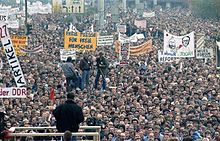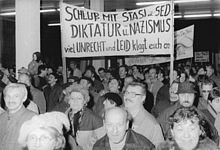This is an old revision of this page, as edited by Zinoural (talk | contribs) at 09:37, 4 February 2014 (Not only in East Germany). The present address (URL) is a permanent link to this revision, which may differ significantly from the current revision.
Revision as of 09:37, 4 February 2014 by Zinoural (talk | contribs) (Not only in East Germany)(diff) ← Previous revision | Latest revision (diff) | Newer revision → (diff)| It has been suggested that Die Wende be merged into this article. (Discuss) Proposed since August 2013. |

The Peaceful Revolution (Template:Lang-de) was a series of peaceful political protests against the regime of the German Democratic Republic (GDR) of East Germany. The protests, which included an emigration movement as well as street demonstrations, were a case of nonviolent resistance, also often called civil resistance. The events were part of the Revolutions of 1989.
In the summer of 1989, the East German government praised the Chinese Communist Party decision to use violence against the Tiananmen Square protesters. Like the People's Republic of China, East Germany had previously used violence against dissidents and it was not clear whether events would develop peacefully. The demonstrations began on Monday, 4 September 1989 at the St. Nicholas Church in Leipzig, led by a Protestant pastor of the church, Christian Führer. After the October 2 demonstration, Socialist Unity Party (SED) leader Erich Honecker issued a shoot to kill order to the National People's Army. The government prepared a huge police (volkspolizei), riot police (Kasernierte Volkspolizei), Stasi, and Combat Groups of the Working Class presence and there were rumors of a looming Tiananmen Square-style massacre.
On October 9, Leipzig's protesters took to the streets under the banner "We are the people!". The military surrounded the demonstrators, but did not take action. The Stasi, East Germany's secret police, unsuccessfully attempted to spark violence by planting violent agent provocateurs in the middle of crowds. Honecker had to resign on October 18.
The non-violent demonstrations were a key component in the fall of the Berlin Wall on 9 November and ultimately led to the fall of the East German regime. German reunification happened within a year, on 3 October 1990.
The complete process of change is known in Germany as Die Wende.
Earlier demonstrations
Further information: Uprising of 1953 in East GermanyOpposition to the East German government and its leader, Walter Ulbricht, had existed since the 1950s. Before the Peaceful Revolution there were a few demonstrations that usually had little to no effect on the regime. In the most significant incident, the uprising of 1953 in East Germany was quickly and violently suppressed by Soviet troops which had been stationed in East Germany. At the time, most of the opposition was left up to the intellectual elite, led by Wolfgang Harich and other like-minded individuals.
The elite resistance ultimately had little to no effect on the government, and ended with its members being incarcerated after a series of show-trials. Until 1989, the only visible form of popular protest was the increasing rate of East Germans that were fleeing to the West. By 1960, already three million East Germans had left the country. In 1961, the East German government, in an attempt to stop the quick decrease of population, constructed the Berlin Wall.
External factors that facilitated the revolution
There were two significant external factors that caused a stir in the East German people, and gave them hope that change was possible, along with increasingly widespread disapproval of the East German regime. In 1985, Mikhail Gorbachev rose to power in Moscow and introduced a new foreign policy, which led to the termination of the Brezhnev doctrine. Firstly, it meant that Moscow’s allies, including East Germany, could no longer count on Soviet foreign military aid. Secondly, it also meant that the East German government was left alone in trying to control the growing internal threat presented by its own citizens.
The Peaceful Revolution


By September 1989, the East German people had become more unruly, and many opposition movements were created. Among them were the Neues Forum (New Forum), Demokratischer Aufbruch (Democratic Awakening), and Demokratie Jetzt (Democracy Now). The largest opposition movement was created through a Protestant church service at Leipzig’s Nikolaikirche, German for Church of Saint Nicholas, where each Monday after service citizens gather outside demanding change in East Germany.
The demonstrators' strong tie to the church helped assure the peaceful nature of the demonstrations. The group grew from week to week and by 9 October 1989 there were 120,000 non-violent protestors, and a week later there were 320,000. Once other East Germany cities, such as East Berlin, Karl-Marx-Stadt, and Potsdam, heard about the Leipzig demonstrations, they, too, began meeting on Monday nights at the city squares. On 4 November 1989 over 500,000 East Germans gathered in protest in the streets of East Berlin. These demonstrations were called Monday demonstrations.
After the October 2 demonstration, Socialist Unity Party leader Eric Honecker issued a shoot to kill order to the military.
The East German government prepared a huge police (Volkspolizei), the anti-riots police (Kasernierte Volkspolizei), Stasi, and work-combat troop presence and there were rumors of a Tiananmen Square-style massacre.
On 9 October, Leipzig's anti-communists took to the streets under the banner "We are the people!". Communist military surrounded the demonstrators, but did not take action despite orders from the Socialist Unity Party. The Stasi attempted to spark violence by planting violent demonstrators in the middle of crowds.
The severity in the size of the demonstrations proved that the majority of the population was against the regime. “We are the people” was the main chant of the non-violent protestors that could be heard echoing throughout the streets of East Germany. It came to symbolize the power of the people united against its oppressive government. They wanted democracy, free elections and freedom of mobility.
By the middle of October, East Germans were leaving the country at a rate of 10,000 per day. The massive exodus was taking a toll on the country's infrastructure. Combined with the large non-violent demonstrations carried out throughout the country, it was enough to force Honecker to resign on 18 October, in favour of his top lieutenant, Egon Krenz. Several other members of the Politburo also resigned that day, including Margot Honecker, Erich Mielke, Kurt Hager, and Hans Tisch. By 7 November 1989 the entire government, under Willi Stoph resigned.
Then, on 9 November 1989, the Politburo voted to allow East Germans to go to West Germany directly through East Germany. Günter Schabowski, the party boss of East Berlin, was charged with making the announcement. However, he didn't know that the regulations were to take effect the next day. When asked when the regulations were to take effect, he replied, "As far as I know effective immediately, without delay." Later that evening, pictures were broadcast all over the world of thousands climbing and tearing down the Berlin Wall in the presence of the helpless East German guards that could do nothing about it. In the following days, thousands of East Germans were free to come and go as they pleased, a right that had been denied to them for years. In December 1989, the entire Politburo, including Krenz, resigned. Shortly afterward, the SED gave up its guaranteed right to rule. The demonstrations eventually ended in March 1990, around the time of the first free multi-party elections.

Reunification
Main article: German reunificationSee also
- Civil resistance
- Die Wende
- East Berlin
- Erich Mielke
- Fall of the Berlin Wall
- Goodbye Lenin!
- History of Germany since 1945
- History of the German Democratic Republic
- Inner German border
- List of Berlin Wall segments
- Nonviolent resistance
- Nonviolent revolution
- Revolutions of 1989
- Stasi
- Tear down this wall
- West Berlin
References
- Charles S. Maier, "Civil Resistance and Civil Society: Lessons from the Collapse of the German Democratic Republic in 1989", in Adam Roberts and Timothy Garton Ash (eds.), Civil Resistance and Power Politics: The Experience of Non-violent Action from Gandhi to the Present, Oxford University Press, 2009, pp. 260-76.
- ^ "A Peaceful Revolution in Leipzig". Spiegel. 2009-10-09.
- ^ Rosalind M. O. Pritchard. Reconstructing education: East German schools and universities after unification. p. 10.
- Cate, Curtis (1978). The Ides of August: The Berlin Wall Crisis—1961. New York City: M. Evans
- ^ Bleiker , Roland. “Nonviolent Struggle and the Revolution in East Germany” The Albert Einstein Institution. 1993.
- Mary Fulbrook. History of Germany, 1918-2000: the divided nation. p. 256.
External links
- Spiegel: A Peaceful Revolution in Leipzig